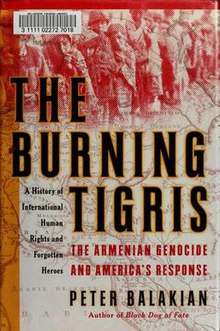The Burning Tigris
The Burning Tigris: The Armenian Genocide and America's Response is a book written by Peter Balakian, and published in 2003. It details the Armenian Genocide, the events leading up to it, and the events following it. It begins with the state of the Ottoman Empire in the 1880s. Abdul Hamid II has come to power, and there are many issues in the country that he is expected to solve. Specifically, the country was losing money and land. Abdul Hamid II blamed these issues on non-Muslims in the country, and in particular, the Armenians. Over the course of the 1890s laws are passed limiting the rights of Armenians in the Ottoman Empire. By the early 20th century, there was extreme overtaxing, robbery, and murder against Armenians, all going with no repercussion. The government began supporting these actions by sending the military to help. As the First World War was fought by the Ottoman Empire, the leader, Abdul Hamid II lost popularity. He was overthrown by a group of people known as the Young Turks. They said they would bring reforms for the Armenians, as well as end the war. Since he said this, the Armenians supported him, thinking that they would be treated as equals once more. Instead, the new government ordered masacres and death marches. Armenians were rounded up and killed. The ones lucky enough to escape the massacres were deported to other countries like Lebanon and Syria. The United States Red Cross was permitted into the country starting in 1915. The help they could provide was limited. The United States Government was also considering trying to help the Armenians by creating a country which they would get after the First World War. Woodrow Wilson and some members of congress supported this idea, but it never worked fully because the United States had oil interests in the Ottoman Empire and wanted to remain on good terms. Armenia instead became a state in the Soviet Union. The United States had ambitious plans for what to do with the Armenians, but economic issues prevented the United States from helping in any meaningful way. Other European powers at the time also did not do much. More than one hundred high-ranking government officials from the Ottoman Empire were put on trial for war crimes, fewer than 20 were convicted, and then none of the served their full sentences.
 | |
| Author | Peter Balakian |
|---|---|
| Country | United States |
| Language | English |
| Genre | History |
| Publisher | HarperCollins |
Publication date | 2003 |
| Pages | 465 |
| ISBN | 978-0-06-019840-4 |
| OCLC | 51653350 |
| 956.6/2015 21 | |
| LC Class | DS195.5 .B353 2003 |
Reception
The book was received quite well in the United States. The historical accuracy of the book is not questionable considering the primary sources it has to prove the information it states correct. Some people who described the book called it "gripping" and "an important and compelling account (of the genocide)." "The Burning Tigris does succeed in resurrecting a little-known chapter of the American and as well as the Armenian history"[1] - The New York Times. The book was praised for the new bits of information it found, such as certain primary sources which were published in the book.
Author
Peter Balakian also wrote poems, translations of Armenian literature to English, and 4 other books relating to the Armenian Genocide and how the United States responded.
Reviews and responses
- Cooper, Belinda (2003-10-19). "Human Rights Watch". New York Times. Retrieved 2008-09-16.
- Mango, Andrew (2004-09-17). "The definition". Times Literary Supplement. Archived from the original on 2013-05-05. Retrieved 2008-09-16.
- Balakian, Peter (2004-10-01). "The history of Armenia". Times Literary Supplement. Retrieved 2008-09-16.
- Walker, Christopher J (2004-10-01). "The history of Armenia". Times Literary Supplement. Retrieved 2008-09-16.
- Joseph, Mike (2004-10-08). "Armenia in history". Times Literary Supplement. Retrieved 2008-09-16.
- Stone, Norman (2004-10-15). "Armenia and Turkey". Times Literary Supplement. Retrieved 2008-09-16.
- Acemoglu, Murat (2004-10-29). "Armenia in history". Times Literary Supplement. Retrieved 2008-09-16.
- Stone, Norman (2004-11-05). "Armenia in history". Times Literary Supplement. Retrieved 2008-09-16.
- Stevens, Philip (2004-11-12). "Armenia in history". Times Literary Supplement. Retrieved 2008-09-16.
- Dadrian, Vahakn N; Feinstein, Stephen (2004-11-19). "Armenia in history". Times Literary Supplement. Retrieved 2008-09-16.
- Stone, Norman (2004-11-26). "Armenia in history". Times Literary Supplement. Retrieved 2008-09-16.
References
- Cooper, Belinda (19 October 2003). "Human Rights Watch". New York Times.